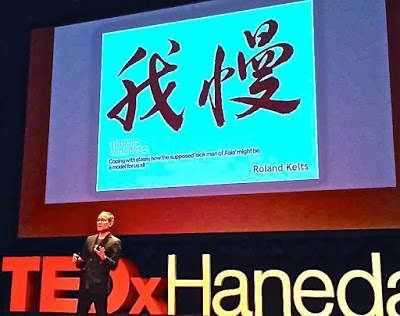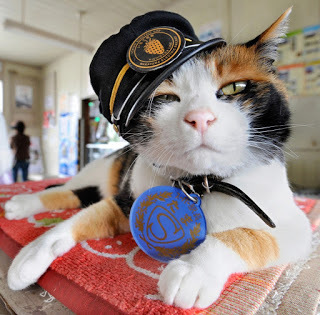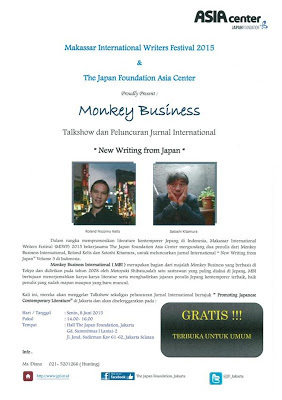Roland Kelts's Blog, page 31
July 22, 2015
My TED Talk in Tokyo @ TedxHaneda
Published on July 22, 2015 15:38
July 16, 2015
Anime meets Hollywood via Project Anime & Anime Expo, for The Japan Times
Project Anime asks the right questions

By Roland Kelts
More than 90,000 attended the 24th annual Anime Expo (AX), North America’s largest Japanese pop culture convention, held at the Los Angeles Convention Center from July 2 to 5. The four-day event featured a concert by idol group Momoiro Clover Z, who were joined onstage by two members of veteran American rockers, Kiss — a result of their unlikely collaboration earlier this year on the song and music video, “Yume no Ukiyo ni Saitemina.” (In March, the two groups also performed together at Kiss’ Tokyo Dome show.)
American producer and DJ Porter Robinson, cable channel mtvU’s artist of the year and an avowed fan of Japanese pop, delivered a surprise set following a gig by Japan-influenced electronic music act, Anamanaguchi.
Sanrio hosted a fashion show to celebrate the 40th year of “Hello Kitty.” The 20th anniversary of Hideaki Anno’s seminal film and series “Evangelion” was marked with a performance by its theme-song singer-songwriter, Yoko Takahashi. Other guest producers and directors who attended included Studio 4°C President and former Studio Ghibli Producer Eiko Tanaka, and Takahiro Miura, director of the popular series “Fate/Stay Night: Unlimited Blade Works.”
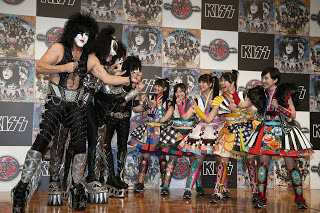
Like most anime cons, AX is primarily focused on pleasing fans. For many who work in the entertainment industry on both sides of the Pacific, a more productive meeting took place just before AX opened. On June 30 and July 1, the SPJA hosted its fourth Project Anime Los Angeles (PA), a conference designed to bring together global convention organizers with Japanese content producers, publishers, artists and licensors. Launched in 2012 to coincide with both AX and AnimeJapan in Tokyo, PA aims to bridge East and West through the business of Japanese pop culture.
Jointly conceived by SPJA CEO Marc Perez and Nobuyuki Takahashi, president of Japanese publisher and designer Studio Hard Deluxe, PA has grown dramatically over the past four years. This month’s installment united 62 organizers from five of the 10 largest conventions in North America and others from conventions in Belgium, Mexico and Canada, with 40 industry representatives from companies including Sony Music Entertainment, Aniplex of America, Bandai Visual, Viz Media, Funimation and Crunchyroll.
“We’ve gone from doing two events a year in L.A. and Tokyo, to doing five this year,” said PA Conference Director, Marlan Moore. “We added Atlanta, Belgium and Singapore. Each region has its own challenges when it comes to running a convention, or even finding Japanese content, so each event will focus on that specific area’s needs.”
I was first introduced to and wrote about PA in the spring of 2014, when I was invited to attend panel presentations and a networking reception in Tokyo’s Akihabara district. For several years I’d been writing about the need to address two seemingly incongruous trends: declining anime DVD and manga sales overseas and skyrocketing attendance numbers at global Japanese pop culture conventions.
Panels this month covered subjects such as the management of international guest relations, garnering media coverage, juggling legal matters, musical performers and the pricing and security of venues. Many of the most invigorating exchanges occurred between panel presentations or at after-hours gatherings, where Japanese content producers and global convention organizers shared business cards and anecdotes, and discussed possibilities for collaboration.
Of particular relevance was the inaugural participation of the Japan External Trade Organization (JETRO), the independent government agency overseeing the promotion of Japanese exports. JETRO hosted what Moore calls a “buyer’s market,” a licensing forum for companies from Japan and Hollywood.
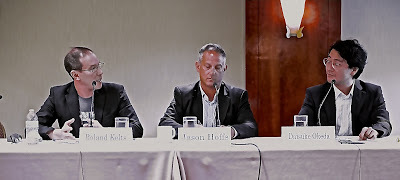 [Roland Kelts, Jason Hoffs, Daisuke Okeda for JETRO -- photo, Jeremy Rafanan]
[Roland Kelts, Jason Hoffs, Daisuke Okeda for JETRO -- photo, Jeremy Rafanan]
“The goal here was to create a space where Japanese production companies could meet with content distributors and Hollywood producers,” he explained, “to hopefully build relationships that could lead to more content being brought abroad.”
I moderated JETRO’s panel, a discussion between Jason Hoffs, producer of “Edge of Tomorrow,” the Tom Cruise film based on Hiroshi Sakurazaka’s novel, “All You Need Is Kill,” and Daisuke Okeda, an intellectual property lawyer. Both admitted that transactional and licensing negotiations between the American and Japanese entertainment industries amount to a Gordian knot: Nothing is clear, none of it is easy, and the track record of ill-fated Hollywood projects such as 2009′s live-action “Dragonball: Evolution” doesn’t help.
Still, for me at least, the fact that issues were being aired at all by seasoned industry professionals in a room packed full of producers, convention staffers and potential licensors and licensees from several countries, signaled a major step forward. And with 90,000 visitors pouring into the Convention Center just blocks away, a potentially meaningful one.
Roland Kelts is the author of “Japanamerica: How Japanese Pop Culture has Invaded the U.S.” He is a visiting scholar at Keio University in Tokyo.

By Roland Kelts
More than 90,000 attended the 24th annual Anime Expo (AX), North America’s largest Japanese pop culture convention, held at the Los Angeles Convention Center from July 2 to 5. The four-day event featured a concert by idol group Momoiro Clover Z, who were joined onstage by two members of veteran American rockers, Kiss — a result of their unlikely collaboration earlier this year on the song and music video, “Yume no Ukiyo ni Saitemina.” (In March, the two groups also performed together at Kiss’ Tokyo Dome show.)
American producer and DJ Porter Robinson, cable channel mtvU’s artist of the year and an avowed fan of Japanese pop, delivered a surprise set following a gig by Japan-influenced electronic music act, Anamanaguchi.
Sanrio hosted a fashion show to celebrate the 40th year of “Hello Kitty.” The 20th anniversary of Hideaki Anno’s seminal film and series “Evangelion” was marked with a performance by its theme-song singer-songwriter, Yoko Takahashi. Other guest producers and directors who attended included Studio 4°C President and former Studio Ghibli Producer Eiko Tanaka, and Takahiro Miura, director of the popular series “Fate/Stay Night: Unlimited Blade Works.”

Like most anime cons, AX is primarily focused on pleasing fans. For many who work in the entertainment industry on both sides of the Pacific, a more productive meeting took place just before AX opened. On June 30 and July 1, the SPJA hosted its fourth Project Anime Los Angeles (PA), a conference designed to bring together global convention organizers with Japanese content producers, publishers, artists and licensors. Launched in 2012 to coincide with both AX and AnimeJapan in Tokyo, PA aims to bridge East and West through the business of Japanese pop culture.
Jointly conceived by SPJA CEO Marc Perez and Nobuyuki Takahashi, president of Japanese publisher and designer Studio Hard Deluxe, PA has grown dramatically over the past four years. This month’s installment united 62 organizers from five of the 10 largest conventions in North America and others from conventions in Belgium, Mexico and Canada, with 40 industry representatives from companies including Sony Music Entertainment, Aniplex of America, Bandai Visual, Viz Media, Funimation and Crunchyroll.
“We’ve gone from doing two events a year in L.A. and Tokyo, to doing five this year,” said PA Conference Director, Marlan Moore. “We added Atlanta, Belgium and Singapore. Each region has its own challenges when it comes to running a convention, or even finding Japanese content, so each event will focus on that specific area’s needs.”
I was first introduced to and wrote about PA in the spring of 2014, when I was invited to attend panel presentations and a networking reception in Tokyo’s Akihabara district. For several years I’d been writing about the need to address two seemingly incongruous trends: declining anime DVD and manga sales overseas and skyrocketing attendance numbers at global Japanese pop culture conventions.
Panels this month covered subjects such as the management of international guest relations, garnering media coverage, juggling legal matters, musical performers and the pricing and security of venues. Many of the most invigorating exchanges occurred between panel presentations or at after-hours gatherings, where Japanese content producers and global convention organizers shared business cards and anecdotes, and discussed possibilities for collaboration.
Of particular relevance was the inaugural participation of the Japan External Trade Organization (JETRO), the independent government agency overseeing the promotion of Japanese exports. JETRO hosted what Moore calls a “buyer’s market,” a licensing forum for companies from Japan and Hollywood.
 [Roland Kelts, Jason Hoffs, Daisuke Okeda for JETRO -- photo, Jeremy Rafanan]
[Roland Kelts, Jason Hoffs, Daisuke Okeda for JETRO -- photo, Jeremy Rafanan]“The goal here was to create a space where Japanese production companies could meet with content distributors and Hollywood producers,” he explained, “to hopefully build relationships that could lead to more content being brought abroad.”
I moderated JETRO’s panel, a discussion between Jason Hoffs, producer of “Edge of Tomorrow,” the Tom Cruise film based on Hiroshi Sakurazaka’s novel, “All You Need Is Kill,” and Daisuke Okeda, an intellectual property lawyer. Both admitted that transactional and licensing negotiations between the American and Japanese entertainment industries amount to a Gordian knot: Nothing is clear, none of it is easy, and the track record of ill-fated Hollywood projects such as 2009′s live-action “Dragonball: Evolution” doesn’t help.
Still, for me at least, the fact that issues were being aired at all by seasoned industry professionals in a room packed full of producers, convention staffers and potential licensors and licensees from several countries, signaled a major step forward. And with 90,000 visitors pouring into the Convention Center just blocks away, a potentially meaningful one.
Roland Kelts is the author of “Japanamerica: How Japanese Pop Culture has Invaded the U.S.” He is a visiting scholar at Keio University in Tokyo.
Published on July 16, 2015 06:25
My new column for JT
Published on July 16, 2015 06:25
July 15, 2015
Project Anime! LA
Published on July 15, 2015 08:46
July 2, 2015
On Tama, Japan's cat stationmaster, for PRI's "The World"
Published on July 02, 2015 18:56
June 20, 2015
The future of streaming music in Japan, for The Japan Times
Can #socialmedia boost music sales in Japan?
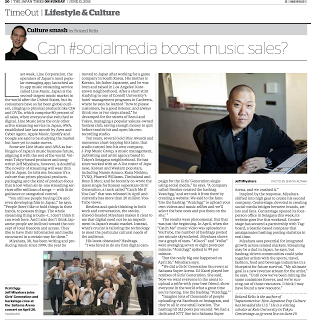
By Roland Kelts
Last week, Line Corp.’s, the operators of Japan’s most popular messaging app, launched an in-app music streaming service called Line Music. Japan is the second-largest music market in the world after the United States, but its consumers have so far been global outliers, clinging to physical products like CDs and DVDs, which comprise 80 percent of all sales, when everyone else switched to digital. Line Music joins the only other active streaming service in Japan, AWA, established late last month by Avex and Cyber Agent. Apple Music, Spotify and Google are said to be studying the market but have yet to make moves.
Some see Line Music and AWA as harbingers of Japan’s music business future, aligning it with the rest of the world. Veteran Tokyo-based producer and songwriter Jeff Miyahara, however, is doubtful. The novelty of streaming will wear thin fast in Japan, he tells me, because it’s a culture that prizes physical products, packaging and the kind of product-focus that is lost when all-in-one streaming services offer millions of songs — with little guidance or categorical control.“You still see people buying CDs and even developing film in Japan,” he says. “People (here) like to hold things in their hands, to possess things. The whole streaming thing is bulls—t. I don’t think it can work here. And I also don’t think Japanese people are inclined toward the concept of total freedom and access. They like to have their information and media structured in a certain way for them.”
Miyahara, 38, has been writing and producing music since 1999, the year he moved to Japan after working for a game company in South Korea. His mother is Korean, his father Japanese, and he was born and raised in Los Angeles’ Korea-town neighborhood. After a short stint studying in one of Cornell University’s hotel-management programs in Canberra, where he says he learned “how to please customers, be a good listener, and always think one or two steps ahead,” he decamped for the streets of Seoul and Tokyo, managing a popular yakuza-owned hostess club, saving enough money to quit before trouble hit and open his own recording studio.
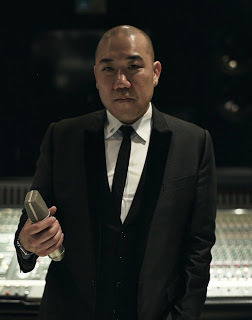 Jeff Miyahara (photo by Keisuke Tzuji)
Jeff Miyahara (photo by Keisuke Tzuji)
Ten years, several Gold Disc Awards and numerous chart-topping hits later, that studio turned into his own company, J-Pop Music Group, a music management, publishing and artist agency based in Tokyo’s Setagaya Ward. He has since worked with an A-list roster of Japanese, Korean and Western pop stars, including Namie Amuro, Kana Nishino, TVXQ, Pharrell Williams, Timbaland and Boyz II Men, and he recently co-wrote the latest single for Korean superstars Girls’ Generation, a track called “Catch Me If You Can” that was released in April and currently has more than 20 million YouTube views.
Restless and quick-thinking in both work and conversation, the stocky, shaved-headed Miyahara makes it clear to me that digital need not be an impediment in Japan’s music market. Instead, what’s crucial is tailoring the technology to meet the particular cultural needs of the audience.
His latest obsession? Hashtags.
“I was hired to do my first digital campaign for the Girls’ Generation single using social media,” he says. “A company called Breaker created the hashtag ‘#catchgg,’ and we took it from there by creating a website. We said to the fans: ‘Use the hashtag “#catchgg” to upload your own videos and music selfies and we’ll select the best ones and put them on the site.’ “
The results were phenomenal. But that was just the beginning. In April, when the “Catch Me” music video was uploaded to YouTube, the number of hashtags posted per minute skyrocketed. Miyahara shows me a graph of stats. “#Gucci” and “#nike” were averaging seven or eight posts per minute; “#catchgg” spiked to 99 per minute.
“But the really big one happened on April 26,” Miyahara says.
“We did a Girls’ Generation fan event at Saitama Super Arena. DJ Kaori played her remixes of Girls’ Generation. She said, ‘Now we want everyone in the arena to upload a selfie with your best friend, show everyone in the world what a great time you’re having. Use the hashtag “#catchgg.” ‘
“Imagine tens of thousands of people uploading via Facebook or Instagram, and they’re all in one small location. The hashtag hit 512 posts per second. We had a dedicated NTT line into Saitama Super Arena, and we crashed it.”
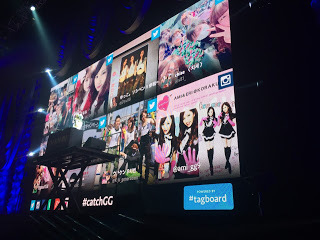
Inspired by the response, Miyahara shifted into high gear to create his second company, Centerstage, devoted to building social-media bridges between brands, artists and fans. Centerstage opened its four-person office in Setagaya this week; its website goes live this weekend. Centerstage has secured a partnership with Tagboard, a Seattle-based company that amalgamates hashtag posting statistics in real time.
Miyahara sees potential for integrated growth across related markets. Streaming may be a dud in Japan, he says, but hashtag-driven communities could yoke together artists with the sports, travel, fashion, food and beverage industries in a blueprint for future survival. “My ultimate goal is a new revenue stream for the artist,” he says. “Until now we’ve been mining the same coalmines forever, and we’re running out of those resources. I think I may have found a new resource.”
Roland Kelts is the author of “Japanamerica: How Japanese Pop Culture has Invaded the U.S.” He is a visiting scholar at Keio University in Tokyo. Centerstage.co.jp went live on June 19.

By Roland Kelts
Last week, Line Corp.’s, the operators of Japan’s most popular messaging app, launched an in-app music streaming service called Line Music. Japan is the second-largest music market in the world after the United States, but its consumers have so far been global outliers, clinging to physical products like CDs and DVDs, which comprise 80 percent of all sales, when everyone else switched to digital. Line Music joins the only other active streaming service in Japan, AWA, established late last month by Avex and Cyber Agent. Apple Music, Spotify and Google are said to be studying the market but have yet to make moves.
Some see Line Music and AWA as harbingers of Japan’s music business future, aligning it with the rest of the world. Veteran Tokyo-based producer and songwriter Jeff Miyahara, however, is doubtful. The novelty of streaming will wear thin fast in Japan, he tells me, because it’s a culture that prizes physical products, packaging and the kind of product-focus that is lost when all-in-one streaming services offer millions of songs — with little guidance or categorical control.“You still see people buying CDs and even developing film in Japan,” he says. “People (here) like to hold things in their hands, to possess things. The whole streaming thing is bulls—t. I don’t think it can work here. And I also don’t think Japanese people are inclined toward the concept of total freedom and access. They like to have their information and media structured in a certain way for them.”
Miyahara, 38, has been writing and producing music since 1999, the year he moved to Japan after working for a game company in South Korea. His mother is Korean, his father Japanese, and he was born and raised in Los Angeles’ Korea-town neighborhood. After a short stint studying in one of Cornell University’s hotel-management programs in Canberra, where he says he learned “how to please customers, be a good listener, and always think one or two steps ahead,” he decamped for the streets of Seoul and Tokyo, managing a popular yakuza-owned hostess club, saving enough money to quit before trouble hit and open his own recording studio.
 Jeff Miyahara (photo by Keisuke Tzuji)
Jeff Miyahara (photo by Keisuke Tzuji)Ten years, several Gold Disc Awards and numerous chart-topping hits later, that studio turned into his own company, J-Pop Music Group, a music management, publishing and artist agency based in Tokyo’s Setagaya Ward. He has since worked with an A-list roster of Japanese, Korean and Western pop stars, including Namie Amuro, Kana Nishino, TVXQ, Pharrell Williams, Timbaland and Boyz II Men, and he recently co-wrote the latest single for Korean superstars Girls’ Generation, a track called “Catch Me If You Can” that was released in April and currently has more than 20 million YouTube views.
Restless and quick-thinking in both work and conversation, the stocky, shaved-headed Miyahara makes it clear to me that digital need not be an impediment in Japan’s music market. Instead, what’s crucial is tailoring the technology to meet the particular cultural needs of the audience.
His latest obsession? Hashtags.
“I was hired to do my first digital campaign for the Girls’ Generation single using social media,” he says. “A company called Breaker created the hashtag ‘#catchgg,’ and we took it from there by creating a website. We said to the fans: ‘Use the hashtag “#catchgg” to upload your own videos and music selfies and we’ll select the best ones and put them on the site.’ “
The results were phenomenal. But that was just the beginning. In April, when the “Catch Me” music video was uploaded to YouTube, the number of hashtags posted per minute skyrocketed. Miyahara shows me a graph of stats. “#Gucci” and “#nike” were averaging seven or eight posts per minute; “#catchgg” spiked to 99 per minute.
“But the really big one happened on April 26,” Miyahara says.
“We did a Girls’ Generation fan event at Saitama Super Arena. DJ Kaori played her remixes of Girls’ Generation. She said, ‘Now we want everyone in the arena to upload a selfie with your best friend, show everyone in the world what a great time you’re having. Use the hashtag “#catchgg.” ‘
“Imagine tens of thousands of people uploading via Facebook or Instagram, and they’re all in one small location. The hashtag hit 512 posts per second. We had a dedicated NTT line into Saitama Super Arena, and we crashed it.”

Inspired by the response, Miyahara shifted into high gear to create his second company, Centerstage, devoted to building social-media bridges between brands, artists and fans. Centerstage opened its four-person office in Setagaya this week; its website goes live this weekend. Centerstage has secured a partnership with Tagboard, a Seattle-based company that amalgamates hashtag posting statistics in real time.
Miyahara sees potential for integrated growth across related markets. Streaming may be a dud in Japan, he says, but hashtag-driven communities could yoke together artists with the sports, travel, fashion, food and beverage industries in a blueprint for future survival. “My ultimate goal is a new revenue stream for the artist,” he says. “Until now we’ve been mining the same coalmines forever, and we’re running out of those resources. I think I may have found a new resource.”
Roland Kelts is the author of “Japanamerica: How Japanese Pop Culture has Invaded the U.S.” He is a visiting scholar at Keio University in Tokyo. Centerstage.co.jp went live on June 19.
Published on June 20, 2015 00:33
Latest column for The Japan Times
Published on June 20, 2015 00:33
June 19, 2015
The Daily ShowGet More: Daily Show Full Episodes,The Dail...
The Daily Show
Get More: Daily Show Full Episodes,The Daily Show on Facebook,Daily Show Video Archive
Published on June 19, 2015 09:00
June 16, 2015
"The Fifth Flavor," for Guernica magazine
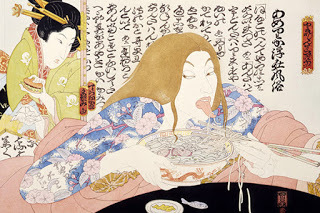
The Fifth Flavor
By Roland Kelts
Umami gives identity and intricacy to mother’s milk, a bowl of ramen, a writer poised between Japan and America.
“Be always beginning,” Rilke wrote. You begin again because you have no choice. When I was six, my Japanese mother took me to her hometown to live with my grandparents. In Morioka, a northern capital city, I attended the neighborhood kindergarten. My memories of those days are uniformly positive: hunting cicadas in the backyard with a store-bought child’s-net-and-terrarium set (cicada-catching is standard summer fare for Japanese kids); watching Ultraman monster shows, animation, and sumo wrestling on TV, seated beside my grandfather, both of us barefoot on the ribbed tatami mats; and bathing nightly in my grandparents’ stainless-steel tub, encased in dark wood-paneled walls.
But my mother tells me I was miserable, especially at school. I cried so hard and often that the principal called home in the middle of the day and asked her to please pick me up. I struggled with the language, the differences in cultural assumptions and attitudes, my alien looks and their alien food. I learned Japanese songs and chants and games that I can recite and play to this day, but I could not learn how to be Japanese.
Instead, I learned how to navigate the margins. It is wise, for example, to shut up if you don’t know the local language. Ten months later we returned to America, and my parents moved us nine times before I entered high school. Introduced to classes, usually mid-year, escorted by a teacher with a hand at my shoulder, I learned to say only what was necessary, to answer and ideally stanch further inquiry. To eye others when they weren’t looking, to see what they were looking at. To gauge reputations before seeking friendships, and to measure how each teacher was being assessed by the class. Was this one cool, respected, feared, or distrusted? How to behave amid this one’s approbation or that one’s dismissal?
The concept of umami, the so-called fifth taste, after salty, sweet, sour, and bitter, still feels, at least on paper, like a bit of pseudo-scientific nihonjinron—the postwar academic fetishization of Japan’s uniqueness and need to be misunderstood. That said, there is a science around it. Umami is ascribed to the combination of glutamate with flavors found innately in natural foods, particularly fish and meats. Its English definition, “a pleasant savory taste,” does not capture its character, which is difficult to pin down. It is long-lasting, it coats the tongue and the palate, leaving a mark in the mouth and on the senses. It gives a thing its identity, its substance, its body, its backbone.
I didn’t have much choice, but I could choose to embrace being an unknown quantity, rather than running from or struggling to obscure my differences. It was important to stand out without sticking out. To hide the fact that I played soccer, for instance, and then get myself elected captain and MVP; to skate alone daily till dusk on a local pond so I could be a surprise center on the hockey team the following year; to practice drumming after school until dinner in the privacy of my room so I could emerge in a band at the high school dance.
When the phone rang late at night, it was Japan calling, and my mother turned into another self, her shoulders stiffening.
In America, I had no idea what to make of my Japanese-ness. I didn’t find it useful or revealing, and there seemed to be no glamor or romance in it. Most of my friends and classmates reacted numbly if I divulged my Japanese middle name or brought up my heritage. On one occasion, my mother, who rarely came to athletic events, showed up at a hockey game. “Holy shit,” one of my teammates said, leaning forward and squinting down the bench at me. “That’s your mom?” He nodded toward my parents in the bleachers. “I didn’t know your mom was a Chink. Woah.” His epithet was voiced with such blank innocence and surprise that it would have taken too much effort to correct him.
My mother gave up her Japanese passport and became an American citizen just before she married my father in 1967. For most of my childhood she was determined to speak and live like an American, to attain a cultural and linguistic fluency that was hard-won. There were traditional Japanese dolls in the house, framed strips of calligraphy on the walls, and piles of Japanese fashion magazines on the coffee table that my mother continues to receive through subscription. But despite these my mother tried hard to assimilate. We spoke English at home. We had Japanese food once in a while, but it was usually tailored to my father’s then quite American palate—sukiyaki with its rich beef broth, breaded chicken and pork katsu filets, and mild-tasting rice-based dishes. My grandparents, uncle, aunt, and cousins visited us in the United States, but familial communication was hobbled by language limitations on both sides; mostly everyone nodded and laughed excessively. When the phone rang late at night, it was Japan calling, and my mother turned into another self, speaking Japanese into the handset, her shoulders stiffening.
America was isolating. But there is no better salve for alienation than altitude. In my early teens, I came to love visiting Japan. Ascending to 30,000 feet in a plane, watching the New England and New York State landscapes shrink into swatches of green and crooked beige-blue below, I felt both liberated from, and superior to, my classmates, my teammates. Where were they now, now that they were faceless specks or less? I was rocketing to another planet, where their oxygen tanks would fail, their compasses demagnetize. My then rock n’ roll hero, The Who’s Pete Townshend, sang in “Quadrophenia”: “I have to work myself to death just to fit in.” Not up here. Not in Japan.
I went with my mother during summer vacations, and for years, I shared my experiences with precisely none of my American friends. Because of the limited amount of fuel passenger planes could hold and a lack of access to Soviet airspace, flying to Japan from the American East Coast took much longer back then. The trip would last at least two days and required an overnight in a Canadian or American hotel. In my teens, the chance to board a jet and stay in a hotel felt like a stab at sophistication, a world beyond that of my peers, whose acceptance I both craved and loathed. Traveling to Japan, I soared 500 miles per hour above and away from them, to a place where the language and food and manners and taxis and trains were completely different and in many ways superior—and back in the States they smoked weed by the beach or fucked each other after a football game or polished their Trans Ams.
I took notes in spiral diaries. In Tokyo, I imagined millions of residents dancing, dining, drinking, busy with murder and love. I felt like a musician or writer on the road—even if I was next door to my mother. After all, and after all of her study and behavioral rejiggering, she didn’t fit in anywhere either, and we both knew it.
Umami was discovered, or uncovered and revealed, by Japanese chemist Kikunae Ikeda 107 years ago, when he realized that his bowl of cucumber soup transcended the ephemeral, and wondered why. He landed upon its distinct base: a particular seaweed mix called konbu that not only enriched the experience of its taste, but also quietly enhanced the essences of all the others surrounding it without being overt.
When she arrived in Tokyo, my mother became preoccupied. She had moved to the United States when she was twenty-eight; until then, she’d lived another life. Visits with relatives, former classmates, and friends consumed her schedule, and as I grew older, she extended my leash. Tokyo was vast, but it was also safe. Venturing out on my own was a kick, and I quickly became aware that, far from being offended, most locals were charmed by my attempts to muddle through the Japanese I’d learned as a kindergartner. Ordering a bowl of ramen from a street cart down a Shinjuku alleyway made me feel omnipotent. The soup man asked me elementary-level questions in slow motion, and I answered in solemn tones, eliciting nods of approval from him and his slurping salaryman customers. When I, too, slurped, they smiled.
We’re both trying to talk in borrowed languages, so this must matter.
Tokyo was overstuffed with places I loved: instrument shops with drum and guitar displays that made me salivate; record stores with bootlegs from Europe and Asia that I’d only heard of in vague rumors back home, where store clerks in Boston and New York had told me, “You’ll never find that,” or, “It will cost you a fortune.” They were mine for the taking in Japan. And the girls. The first time I realized that two were staring at me my guard went up. Standing in the record shop, I smelled ridicule, a boy’s kryptonite, until one of them asked, “Hello, how are you?” Stiff, accented, and loud, she didn’t back down; she wanted an answer.
I spoke to her in Japanese—equally stiff and accented, I’m sure. But instead of a sour look or pinched brow, she met me with eye flutters and gutteral laughter. The girls approached me and we had one of those halting, mutually humbling bilingual mash-up conversations that somehow feel more meaningful than a chat in your native tongue. Effort and vulnerability are aphrodisiacal. We’re both trying to talk in borrowed languages, so this must matter.
As a half-Japanese American teenager whose only recourse was outsider appeal, I suddenly realized that Japan was my ideal antipodean audience. In Tokyo, I was an outsider by default, a misfit, an odd flavor, but I did not offend. Instead of struggling to find a strategy to sell to onlookers who didn’t want or need me, I found the Japanese unfazed by my awkwardness, my complexity, my inbetweenness—they liked it, at least seemingly, and that was more than plenty good.
This was also when I fell in love with Japanese food. Into my early adolescence, relatives and Japanese restaurateurs prepared for me a Western kid’s menu separate from the dishes served to the rest. This meant hamburger, pork katsu, hot dogs, bland pizza slices, bread and potato salads. Breakfast was thick slabs of toast smeared with preserves, scrambled eggs and stubby pink sausages or lean Canadian-style bacon.
But my ramen-stand success stayed with me. The instant stuff I’d had in the US for an after-school snack no longer even warranted the name. The pork-bone tonkotsu broth at street carts and narrow back-alley counters was the real thing, and I began to suspect that I’d duped myself. I’d thought that Japanese food was strange, only sometimes good, not worth much thought. The Japanese versions of those Western culinary clichés served only to me were typically bland and unsatisfying. They were missing a center.
It started with the noodles. Soba and udon became something of an obsession. Tempura and fried tofu soba, wanko soba from Morioka, where my grandparents lived, cold soba and dipping sauce, soba and daikon radish. At Japanese restaurants in the States, the flavors never seemed to gel quite right. The salty was too strong, the savory had no bottom, no soul; the sweet was bracing, saccharine.
Umami has recently become a mantra for Western (so-called) celebrity chefs. Britain’s Heston Blumenthal is an avid, pioneering proponent. Blumenthal approaches cooking with a chemist’s alchemy. Umami’s “presence is often undetectable but its impact is undeniable,” he writes. His advocacy has fueled an umami-phenom book and lecture tours, and given the flavor pride of place in British hospital recipes and even a British Airways menu.
My disenchantment with the Japan I found in America fed the conflict with my American-ness. I enjoyed the ritual of Halloween trick-or-treating, for instance, the predictable, initial fun of posing in front of the mirror, selecting and tweaking the costume, then glaring through the mask at a new self—before the banality set in. The anticlimax of joining a procession of parents and other costumed kids, some with better renditions of my own ensemble, was humiliating. And I lacked a sweet tooth; my candy always went stale. Lollipops, gob stoppers, Milky Ways, or Peanut Butter Cups—didn’t matter what it was. Once I got it, I didn’t want it.
Eating ice cream was a chore—too cold gushing into my gums, too cloying. It had no staying power.
Possession gave me pleasure, a thief’s pride. I liked seeing the colorful, branded candy wrappers in the mornings as I dressed and after I returned home from school. But I never felt like opening any of them. Whatever my father failed to pick at sat in a bag or basket on the top of my dresser until it was deemed inedible, usually by my mother, who would toss the loot into the trash.
For a while, I accepted ice cream. It seemed like the right thing to do because it made everyone else giddy. Parents, kids, coaches, bus drivers: all lit up at the approach of an ice cream shop. They licked and puckered and sucked at the stuff with animal bliss. But for me, eating ice cream was a chore—too cold gushing into my gums, too cloying. It had no staying power.
Umami is now ascribed to the essences of meats like beef and lamb and the Italian boilerplate pizza combo of tomato and cheese. It is being touted in American restaurants, even applied as a name to a burger chain that began in California and has spread to New York City. It is thought to be in almost everything, but is still often misunderstood by those who seek to demystify it. It is a taste that is best experienced without the shine of a spotlight. It is an alternative flavor that subtly fulfills. It has been referred to as the elemental life force in breast milk. In short, umami is what needn’t be said: you know it when you get it.
No surprise that in Japan, no one talks about it. Like the givens of life—the soul, love, yearning, death—umami is what binds. That’s it.
When I was fourteen, my friend Dave’s older brother bought us a bottle of gin. Dave and I brought the bottle to our favorite railway bridge. Every bitter sip burned with promise, pointing somewhere beyond our sore and skinny asses, gesturing up to the skies, beyond the menial weights of schooldays and gossip and failed private gestures. The taste made the immediate endure and also referred to what lay past that moment. That night, looking down onto the swamp and cemetery below us, I realized that ice cream did not bring me pleasure. It was a decoy; its flavor was fleeting, superficial. Alcohol lasted, at least long enough to approximate flight.
To me, umami has become the singular, integrated experience of Japanese food, a sense of identity that lingers long after the meal has been eaten. At a recent, disappointing visit to a ramen restaurant in Cambridge, Massachusetts, the problem was clear. The noodles, broth, pork slices, spring onions, seaweed, and bamboo shoots were present, so were their distinctive flavors, yet nothing stuck. There was no middle, no heft, no identity to speak of. It looked as good and was ultimately as unappetizing as those post-Halloween piles of candy that I knew not to eat. A pretty, but fragmented, mess.
Twice in my adult life I have felt stripped of my disguise, the power that I now know to be my actual self, and both times by strangers. Riding the tube in London, I sat across from a swaying white-haired man who eventually slumped into a seat, leaning sideways, his long legs extended, one bent crookedly. He had been watching me as I read. Periodically I glanced up from my book and caught his blue eyes, unflinching. “I know what you are,” he finally said, sucking in breath. “Youse one of them Japanese Americans, aren’t you? A half-Jap, you are. Half-Jap.”
I got off at the next stop, which was far from my own. The man hadn’t followed me, and he was too drunk to be a physical threat. But I was shivering. I had to walk it off.
The unspoken, subterranean character of umami is the thing that feels most Japanese to me—and feels the most like what is Japanese in me. Which is why I shirk an inch at its embrace by the West: as if all you have to do is chemically deconstruct it to understand its power. Once you do that, of course, it has no power.
A few years later, while living in California, I was held up at the video store in Piedmont where I worked the night shift. Just before closing, two men, one black, one white, jogged straight to the counter and thrust a crinkly mid-sized black garbage bag at me. “Put all the money in the bag,” the white guy said. I was stunned, unmoving. The white guy jerked his head. “He’s got a gun.” And soon I felt it, the barrel pressed into my chest like a metal index finger. I put all the money in the bag and they left.
Was I engaged in extracurricular activities, perhaps? Had I had any previous encounters with the accused? Who were my parents?
After a few months, I was on the witness stand. My description had led to the arrest of the duo, whom the Oakland police had dubbed “salt and pepper,” for a series of drug-related crimes, including the murder of a supermarket clerk. I’d picked them out of the police lineup and there they were, seated before me in the chamber in orange jumpsuits. “Look around the courtroom,” I was instructed. “Do you see the accused?”
Their lawyer ripped into me, and the judge let him. What was I doing in California, working in a video store with an East Coast university education? Was I engaged in extracurricular activities, perhaps? Had I had any previous encounters with the accused? Who were my parents? Did my Japanese mother approve of my wayward course in life—working part time, wasting my future and her money? Asians put great stock in education, don’t they? Who was I, really?
Afterward, the cop who’d led me into the courtroom took me to a café and apologized. “I should have prepared you for that,” he said. “That guy’s an asshole, but I should have prepared you for him. You gotta know how important and valuable it is to have you serve as a witness. You’re the only one who didn’t back out, man. You’re doing the right thing.”
I didn’t agree. I felt hollowed out and blank. I’d done the wrong thing. Stepping up when I should have slunk away. They’d turned the spotlight on and I’d walked right into it. With one phone call, tomorrow, those two could have me killed.
But they couldn’t kill me if they didn’t know me, if they couldn’t pin me down. I flew to New York City a few days later, and after secreting myself modestly into Manhattan’s bloodstream, I moved to Japan.
**Roland Kelts is the author of the critically acclaimed and best-selling Japanamerica. His articles, essays, and fiction are published in The New Yorker, Time, the Wall Street Journal, Zoetrope: All Story, The Village Voice, A Public Space, Newsweek Japan, Vogue, Cosmopolitan, The Yomiuri, and the Japan Times, among others. He is also a frequent contributor to CNN, the BBC, NPR, and NHK. He is a visiting scholar at Keio University and contributing editor of Monkey Business, Japan’s premier literary magazine. His forthcoming novel is called Access, and he now divides his time between New York and Tokyo.
Published on June 16, 2015 00:19
June 7, 2015
Thank you, Indonesia
Published on June 07, 2015 17:33

